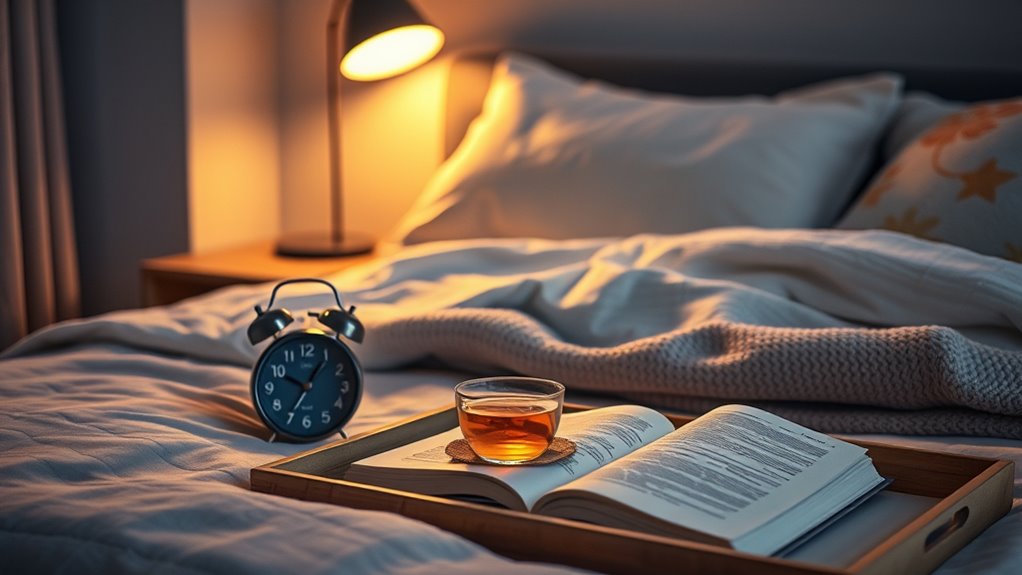In just 10 minutes, you can set yourself up for better sleep by establishing a calming pre-sleep routine, such as deep breathing or light stretching, to relax your mind and body. Make sure your bedroom is cool, dark, and quiet, and reserve your bed strictly for sleep and intimacy to strengthen your sleep association. Small changes like decluttering the space or adjusting the temperature can have a big impact—keep going, and you’ll discover even more ways to optimize your sleep tonight.
Key Takeaways
- Establish a consistent bedtime and wake time, even on weekends, to regulate your internal clock.
- Create a calming pre-sleep routine, such as reading or deep breathing, to signal your body it’s time to relax.
- Optimize your bedroom environment by controlling temperature, reducing noise, and eliminating light sources.
- Reserve your bed for sleep and intimacy only, strengthening the association between your space and restful sleep.
- Dedicate a few minutes each evening to quick routine adjustments, reinforcing sleep habits and promoting restorative rest.
Quick 10-Minute Sleep Hygiene Fixes

Getting a good night’s sleep doesn’t have to be complicated or time-consuming. Sometimes, all it takes is a quick, 10-minute tune-up to improve your sleep hygiene. One of the most effective ways to start is by focusing on your sleep routines. Establishing consistent sleep and wake times helps regulate your body’s internal clock, making it easier to fall asleep and wake up feeling refreshed. Even on weekends, try to stick to your routine to maintain stability. Before bed, create a calming ritual—reading a book, gentle stretching, or practicing deep breathing—to signal to your body that it’s time to wind down. Avoid screens at least 30 minutes before bed, as the blue light emitted can interfere with melatonin production, which is fundamental for sleep. Instead, opt for relaxing activities that help you disconnect and prepare your mind for rest.
Another key component is optimizing your bedroom environment. Your sleep space should be a sanctuary dedicated to rest. Keep the room cool, ideally between 60-67°F (15-19°C), since a lower temperature promotes better sleep. Darkness is equally important; use blackout curtains or a sleep mask to eliminate any light sources that can disrupt your circadian rhythm. Reduce noise by using earplugs or a white noise machine, especially if you’re sensitive to sounds. Your mattress and pillows should support a comfortable posture, so invest in quality bedding that suits your preferences. Declutter your bedroom to create a calming atmosphere—less chaos equals less stress. Also, reserve your bed for sleep and intimacy only, so your brain associates the space strictly with rest, making it easier to fall asleep quickly. Implementing whole-house filtration systems can also improve indoor air quality, creating a healthier environment that supports better sleep.
Combining these simple steps—refining your sleep routines and creating an ideal bedroom environment—can make a significant difference in just 10 minutes. Think of it as a quick reset, a way to tell your body that sleep is a priority. Remember, consistency is key. The more you stick to these habits, the more natural and effortless falling asleep will become. By dedicating a small portion of your evening to these intentional adjustments, you set the stage for deeper, more restorative sleep night after night. So, take a few minutes tonight to tidy up your sleep routines and tweak your bedroom environment—you’ll thank yourself tomorrow morning when you wake up feeling rested and ready to take on the day.
Frequently Asked Questions
Can These Tips Help With Chronic Insomnia?
Yes, these tips can help with chronic insomnia. Improving your sleep environment—like making your room dark, quiet, and cool—creates a calming space. Establishing consistent bedtime routines signals your body it’s time to wind down, making it easier to fall asleep. While they may not cure severe cases, these habits can markedly improve sleep quality over time and support your efforts to manage chronic insomnia effectively.
Are These Fixes Suitable for Shift Workers?
Yes, these fixes can help shift workers deal with irregular schedules. By establishing a consistent sleep routine, even on days off, you can improve sleep quality. Creating a dark, quiet sleep environment and limiting screen time before bed also support better rest. Prioritize sleep hygiene, adapt your schedule when possible, and use strategies like light exposure to manage shift work’s challenges effectively.
How Often Should I Perform These Quick Fixes?
You should perform these quick fixes daily or whenever you notice your sleep routines need a boost. Incorporate consistent bedtime rituals, like winding down with relaxing activities, to reinforce your sleep habits. Doing these simple actions regularly helps your body recognize sleep cues and improves sleep quality over time. Keep it up consistently, especially if your schedule varies, to maintain better sleep hygiene and wake up refreshed.
Do These Tips Work for Children or Teenagers?
Yes, these tips can work for children and teenagers. Establishing consistent bedtime routines helps signal sleep time, while managing screen time before bed reduces disruptions to sleep patterns. You should encourage your child or teen to follow these habits regularly, adjusting routines as needed. Creating a calming environment and limiting evening screen use can considerably improve their sleep quality, making bedtime smoother and more restful.
Can These Adjustments Improve Overall Sleep Quality Long-Term?
Yes, these adjustments can improve your long-term sleep quality. Creating a consistent sleep environment, establishing calming bedtime routines, and limiting screen time before bed help reinforce healthy habits. When you prioritize a comfortable sleep environment and stick to relaxing routines, you signal your body it’s time to rest. Over time, these practices build stronger sleep patterns, making restful nights more natural and lasting, enhancing your overall well-being.
Conclusion
So, in just ten minutes, you’ve learned how easy it is to improve your sleep—no magic pills required. Ironically, the simplest tweaks often make the biggest difference, yet we tend to overlook them. Next time you’re tempted to scroll late into the night, remember, a quick fix might be all you need for better rest. Who knew that just ten minutes could turn your sleep around? Sleep tight—without the fuss.









